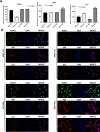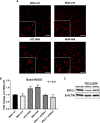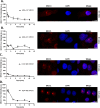Defective base excision repair in the response to DNA damaging agents in triple negative breast cancer
- PMID: 31596905
- PMCID: PMC6785058
- DOI: 10.1371/journal.pone.0223725
Defective base excision repair in the response to DNA damaging agents in triple negative breast cancer
Abstract
DNA repair defects have been increasingly focused on as therapeutic targets. In hormone-positive breast cancer, XRCC1-deficient tumors have been identified and proposed as targets for combination therapies that damage DNA and inhibit DNA repair pathways. XRCC1 is a scaffold protein that functions in base excision repair (BER) by mediating essential interactions between DNA glycosylases, AP endonuclease, poly(ADP-ribose) polymerase 1, DNA polymerase β (POL β), and DNA ligases. Loss of XRCC1 confers BER defects and hypersensitivity to DNA damaging agents. BER defects have not been evaluated in triple negative breast cancers (TNBC), for which new therapeutic targets and therapies are needed. To evaluate the potential of XRCC1 as an indicator of BER defects in TNBC, we examined XRCC1 expression in the TCGA database and its expression and localization in TNBC cell lines. The TCGA database revealed high XRCC1 expression in TNBC tumors and TNBC cell lines show variable, but mostly high expression of XRCC1. XRCC1 localized outside of the nucleus in some TNBC cell lines, altering their ability to repair base lesions and single-strand breaks. Subcellular localization of POL β also varied and did not correlate with XRCC1 localization. Basal levels of DNA damage correlated with observed changes in XRCC1 expression, localization, and measure repair capacity. The results confirmed that XRCC1 expression changes indicate DNA repair capacity changes but emphasize that basal DNA damage levels along with protein localization are better indicators of DNA repair defects. Given the observed over-expression of XRCC1 in TNBC preclinical models and tumors, XRCC1 expression levels should be assessed when evaluating treatment responses of TNBC preclinical model cells.
Conflict of interest statement
The authors have declared that no competing interests exist.
Figures







Similar articles
-
Activated STAT3 Is a Novel Regulator of the XRCC1 Promoter and Selectively Increases XRCC1 Protein Levels in Triple Negative Breast Cancer.Int J Mol Sci. 2021 May 22;22(11):5475. doi: 10.3390/ijms22115475. Int J Mol Sci. 2021. PMID: 34067421 Free PMC article.
-
Triptolide interferes with XRCC1/PARP1-mediated DNA repair and confers sensitization of triple-negative breast cancer cells to cisplatin.Biomed Pharmacother. 2019 Jan;109:1541-1546. doi: 10.1016/j.biopha.2018.11.008. Epub 2018 Nov 14. Biomed Pharmacother. 2019. PMID: 30551406
-
Expression of base excision repair key factors and miR17 in familial and sporadic breast cancer.Cell Death Dis. 2014 Feb 20;5(2):e1076. doi: 10.1038/cddis.2014.30. Cell Death Dis. 2014. PMID: 24556691 Free PMC article.
-
Completion of base excision repair by mammalian DNA ligases.Prog Nucleic Acid Res Mol Biol. 2001;68:151-64. doi: 10.1016/s0079-6603(01)68097-8. Prog Nucleic Acid Res Mol Biol. 2001. PMID: 11554294 Review.
-
XRCC1 and DNA polymerase beta in cellular protection against cytotoxic DNA single-strand breaks.Cell Res. 2008 Jan;18(1):48-63. doi: 10.1038/cr.2008.7. Cell Res. 2008. PMID: 18166976 Free PMC article. Review.
Cited by
-
Activated STAT3 Is a Novel Regulator of the XRCC1 Promoter and Selectively Increases XRCC1 Protein Levels in Triple Negative Breast Cancer.Int J Mol Sci. 2021 May 22;22(11):5475. doi: 10.3390/ijms22115475. Int J Mol Sci. 2021. PMID: 34067421 Free PMC article.
-
Simultaneous Short- and Long-Patch Base Excision Repair (BER) Assay in Live Mammalian Cells.Methods Mol Biol. 2023;2701:3-19. doi: 10.1007/978-1-0716-3373-1_1. Methods Mol Biol. 2023. PMID: 37574472 Free PMC article.
-
DNA damage measurements within tissue samples with Repair Assisted Damage Detection (RADD).Curr Res Biotechnol. 2019 Nov;1:78-86. doi: 10.1016/j.crbiot.2019.11.001. Epub 2019 Nov 15. Curr Res Biotechnol. 2019. PMID: 33997769 Free PMC article.
-
Investigation of the Effects and Mechanisms of Anticancer Action of a Ru(II)-Arene Iminophosphorane Compound in Triple Negative Breast Cancer Cells.ChemMedChem. 2021 Nov 5;16(21):3280-3292. doi: 10.1002/cmdc.202100325. Epub 2021 Aug 24. ChemMedChem. 2021. PMID: 34329530 Free PMC article.
-
Large-scale preparation of fluorescence multiplex host cell reactivation (FM-HCR) reporters.Nat Protoc. 2021 Sep;16(9):4265-4298. doi: 10.1038/s41596-021-00577-3. Epub 2021 Aug 6. Nat Protoc. 2021. PMID: 34363069 Free PMC article.
References
-
- Wolf DM, Yau C, Sanil A, Glas A, Petricoin E, Wulfkuhle J, et al. DNA repair deficiency biomarkers and the 70-gene ultra-high risk signature as predictors of veliparib/carboplatin response in the I-SPY 2 breast cancer trial. NPJ Breast Cancer. 2017;3:31 10.1038/s41523-017-0025-7 - DOI - PMC - PubMed
-
- Abdel-Fatah TM, Russell R, Agarwal D, Moseley P, Abayomi MA, Perry C, et al. DNA polymerase beta deficiency is linked to aggressive breast cancer: a comprehensive analysis of gene copy number, mRNA and protein expression in multiple cohorts. Mol Oncol. 2014;8(3):520–32. 10.1016/j.molonc.2014.01.001 - DOI - PMC - PubMed
Publication types
MeSH terms
Substances
Grants and funding
LinkOut - more resources
Full Text Sources

